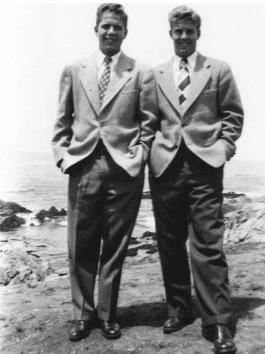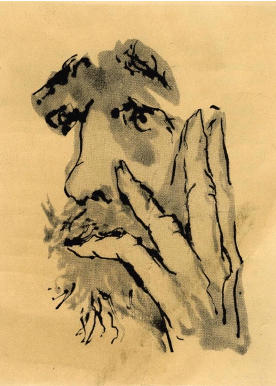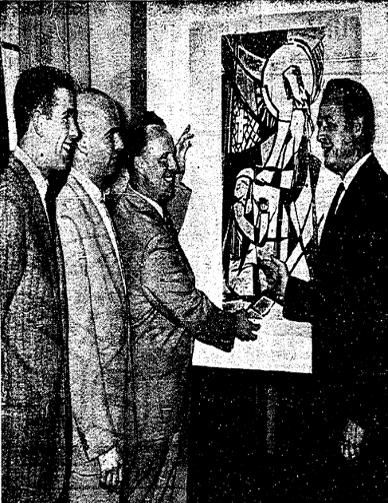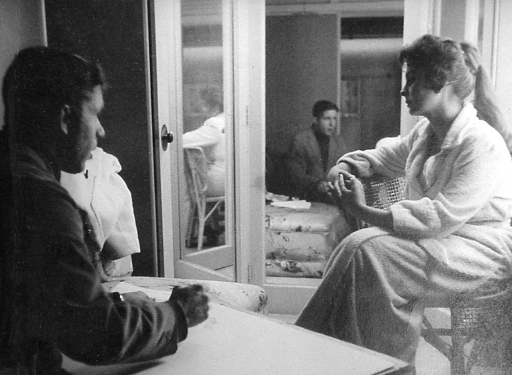1931–1959
Tom (left) and Merritt Van Sant, 1947
Van Sant in the Stanford Cadets, front and center, c. 1951
One of Tom Van Sant’s sketches of Gerald Heard reproduced in Faith and Freedom, pen and wash, 1956
Tom Van Sant, Joel Edwards, and R. Freeman Worthley with Millard Sheets at their graduation in June 1957
TVS drawing actress Jean Simmons on the Spartacus set, 1959
February 26, 1931: Thomas Rowley Van Sant (“TVS”) is born in Los Angeles, CA, to homemaker Martha and insurance broker Merritt E. “Muggs” Van Sant.
1940: 9-year-old TVS is living in Beverly Hills with his parents, older brother Merritt Jr., and Fern Geminer.
1949: TVS graduates from Beverly Hills High School where “he was elected student body president and earned varsity letters in football and track. Classmates selected him as the Most Popular Senior.” He begins his undergraduate student career at Stanford University. In his sophomore year he is hurt while playing football and starts to take art lessons.
1950: The Van Sant family live in San Marino where, according to the LA Times, “no fairyland could compare with the beautiful gardens.”
1952: TVS studies with family friend Millard Sheets at Scripps Art School, Pomona College.
Spring 1953: TVS, his father, and Millard Sheets take a month-long painting trip to Mexico and Hawaii.
June 1953: TVS graduates with a Bachelor of Arts degree from Stanford University.
[NOTE: It was possibly at Stanford that TVS was introduced to psychedelic drugs. From 1953-c.1973, Stanford University was a locus for studies of LSD and other psychedelics, which were carried out under the aegis of the CIA’s illicit MK–Ultra program. In 1958-9 for example, author Ken Kesey volunteered for MK-Ultra experiments as a Stanford student, while friends of TVS report that he recounted having “turned on” counter-culture icon Timothy Leary. The introduction may also have happened later. Possibly through TVS’s close friendship with LSD research pioneer Oscar Janiger, or through contact with philosopher Gerald Heard, a close friend of Aldous Huxley, author of Doors of Perception.]
Sept. 1953: TVS exhibits watercolors from Mexico and Hawaii at the University Club (likely at USC).
1954-1955: TVS is stationed in Korea and Japan as a commissioned Lieutenant in a US Marine Corps.
1955-1957: TVS uses his GI Bill to attend the MFA program at the L.A. County Art Institute (previously Otis Art Institute, now Otis College of Art & Design). The new program was established by Millard Sheets, with Merritt E. Van Sant functioning as President of the school’s Board of Governors.
1956-1959: TVS gets a part-time job as Art Director and illustrator for Faith & Freedom Magazine. He is paid $35 a month.
June 1956: TVS sketches philosopher and forefather of the 1960s consciousness development movement for Faith & Freedom. Heard becomes a mentor for the young artist.
“I was asked to go do drawings of philosopher Gerald Heard. And he was talking to some other people, and I was sitting on the floor and doing pen-and-ink drawings of him. Well, it got dark. And I continued to draw. And I could barely see the page that I was drawing on, but I was so entranced by this elderly man and his beauty of speech and the richness of his ideas that I was really engaged in that when I was drawing. And I was shocked to find when I got home that these drawings pleased me very much.”[i]
Image: One of Tom Van Sant’s sketches of Gerald Heard reproduced in Faith and Freedom, pen and wash, 1956.
1956: Having won a student competition, TVS paints mural Union Union, for Retail Clerks Union 707.
June 12, 1957: TVS graduates with an MFA from the LA County Art Institute. The Institute’s first graduating cohort has 3 students: Tom, Joel Edwards, and R. Freeman Worthley. Van Sant’s graduation work, a glass mosaic titled Fire, Earth, and Water, adorns the entrance of the Institute’s new ceramics block for decades.
Image: Tom, Joel Edwards, and R. Freeman Worthley with Millard Sheets at their graduation
1957-1965: TVS teaches drawing, painting, and design as a member of adjunct faculty at the L.A. County Art Institute/Otis College of Art & Design.
Fall 1957: “My first studio then was in an abandoned glue factory alongside the Southern Pacific Railroad tracks in Atwater...three other artists and I rented this place. And we built a bronze foundry and poured bronze for projects.”[ii]
1958: TVS tours Europe with Nancy Hale and then travels alone to the Middle East as a “war correspondent,” sketching scenes and interviewing people; including: “the commanding officer of all the British troops in Cypress...Bishop Makarios, and all the famous persons...[and] the king of Jordan.” [iii]
1958: TVS makes two works for Millard Sheets projects in Texas: New World Conquest and Muskie.
Feb. 2, 1959: The LA Times prints TVS’s Sketches From the Middle East alongside an article by TVS
about the ‘Cypress Emergency.’ Presaging TVS’s support for democratic self-determination that is so evident in the Goddess of Democracy (1989), he concludes: “at this stage they will accept a transitory stage of limited self-government...The period of self-government must be followed by guaranteed independence...It will be a challenge to both our ideals and prestige.”[iv]
March 1959: TVS exhibits paintings, drawings, mosaics, and sculpture at the L.A. County Art Institute, including pen and wash drawings from Europe and the Middle East. Guests include his family, Millard Sheets, Maj. Gen. Kenneth P. McNaughton USAF ret., and “Mrs. Howard Ahmanson, wearing a striking hat of black silk with its own tiara, served coffee from a brass urn.”[v]
1959: TVS develops a technique to make murals using natural stone that entails pre-casting the stones in epoxy resin. He uses it to make two mosaics for architects Smith, Powell & Morgridge: Transportation of Water for the American Pipe and Construction Company in Monterey Park, CA, and Tree of Life for the San Marino Congregational Church, San Marino, CA. His work receives an American Institute Of Architects Award For Art and Craftsmanship, Southern California Chapter.
1959-1960: TVS makes drawings of the action and actors on the set of the movie Spartacus. His Spartacus Drawings are used as promotional materials and published in an illustrated version of the novel on which the film is based. Tom’s drawings receive the Golden Brush Award from Illustrators West.
[NOTE: Directed by Stanley Kubrick and released on October 6th, 1960, Spartacus was slammed as Marxist propaganda by right-wing Hollywood, including John Wayne. Partly because the screenwriter, Dalton Trumbo, had been blacklisted as one of the Hollywood Ten, and partly because by glorifying collective action and the 'common man,' the movie contained "subtle communistic touches."[vi]]
[i] Jo Lauria, TVS Interview for Smithsonian, 2008.
[ii] Ibid.
[iii] Ibid.
[iv] Ibid.
[v] Elizabeth Goodland, “Thomas Van Sant: Artist's Exhibit Wins Plaudits,”Los Angeles Times, Mar 6, 1959, pg. A2
[vi] James Ten Eyck, The Life and Times of Walter Reuther, Page Publishing, INC. New York, NY, 2016, pp.





